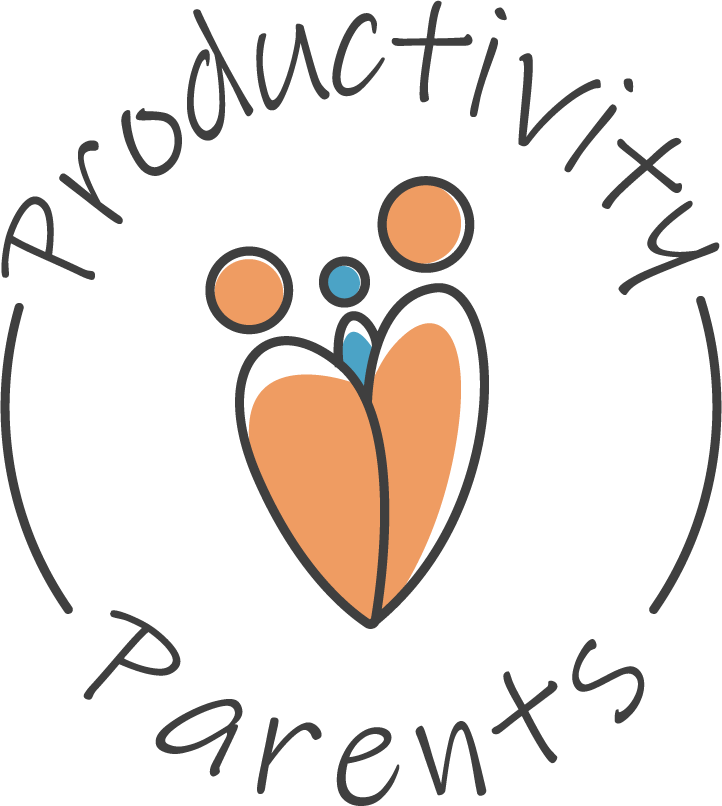In today’s digital age, the clutter in our lives extends beyond physical spaces into our digital worlds. I’ve found that leveraging technology can transform chaos into calm, both in our homes and on our devices. The right tech tools can simplify organization, streamline daily tasks, and create systems that practically maintain themselves. From digital organization tools for managing family calendars to apps that help with decluttering, technology offers countless solutions to our organizational challenges.
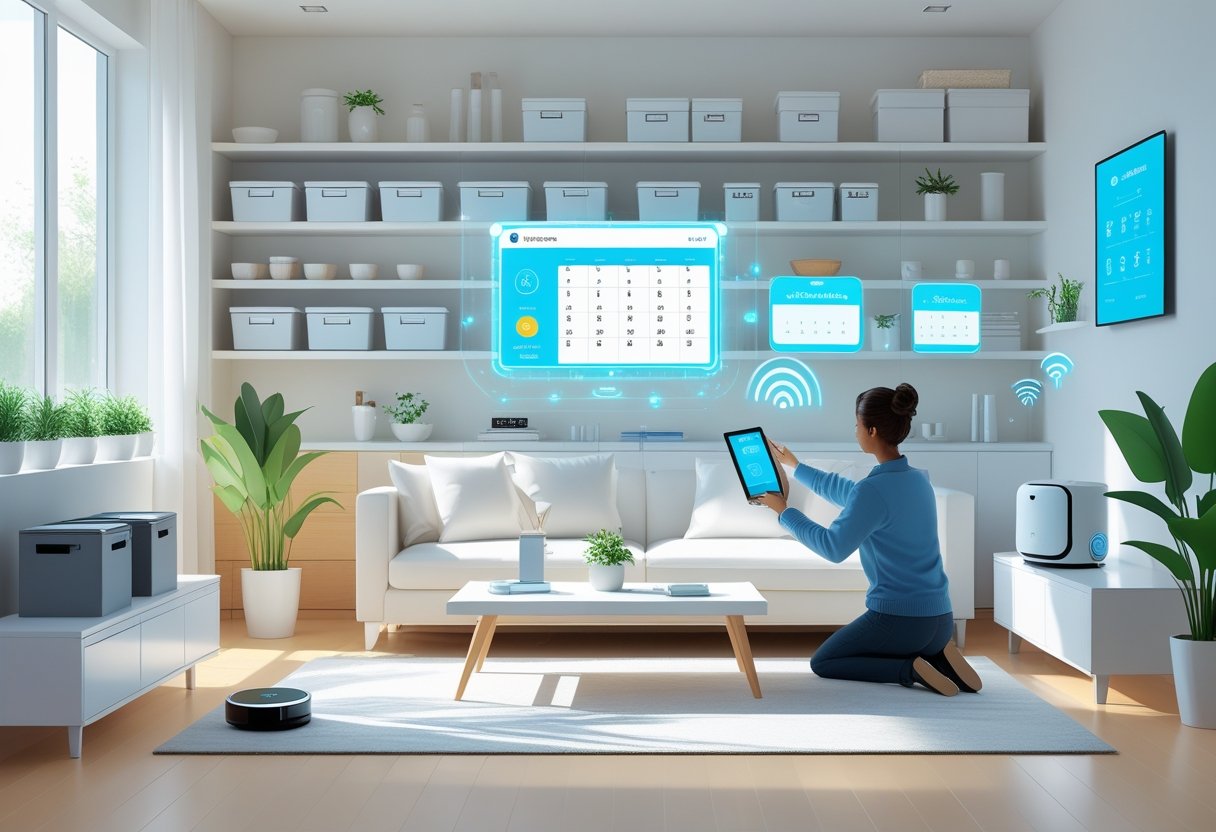
When I began my own decluttering journey, I discovered that a combination of smart home devices and thoughtful digital systems created the most impact. The key is finding tools that work with your lifestyle rather than adding complexity. Many people struggle with digital overwhelm, but implementing a simple digital declutter checklist can bring immediate relief and create sustainable organizational habits.
Key Takeaways
- Effective decluttering combines both physical organization solutions and digital streamlining techniques to create comprehensive systems.
- Smart home technology and organizational apps work best when selected to match your specific lifestyle needs and daily routines.
- Regular maintenance through automated systems and family coordination tools ensures your organizational systems remain effective long-term.
The Benefits of Decluttering With Technology

Technology offers powerful solutions for organizing our spaces more efficiently and maintaining order in our daily lives. Digital tools have transformed how we approach decluttering by providing structure, automation, and motivation.
How Tech Tools Simplify Organization
Digital inventory apps make tracking possessions remarkably straightforward. I’ve found that apps like Sortly and Memento Database allow me to catalog items with photos, descriptions, and location tags, eliminating the guesswork of “where did I put that?”
Smart storage solutions incorporate technology directly into organization systems. Products with QR code labels connect physical storage with digital tracking, making it simple to locate items in storage bins or boxes.
Voice assistants streamline the process further. I can create shopping lists, set reminders for donation pickups, or document storage locations hands-free while actively organizing. This simultaneous physical and digital organization creates a seamless system.
Cloud-based document management eliminates paper clutter. By scanning important documents and storing them securely online, I’ve reduced file cabinets to a fraction of their former size while improving accessibility.
Reducing Stress and Improving Productivity
Digital decluttering leads to improved focus and productivity in our physical spaces. When both digital and physical environments are organized, cognitive load decreases significantly.
Automation eliminates repetitive organizational tasks. Smart home systems can manage routine chores like sorting mail, scheduling cleanings, or tracking household supplies, freeing mental energy for more important matters.
Time management apps help establish decluttering routines that stick. I schedule regular 15-minute tidying sessions using apps like Todoist or Google Calendar, making organization a sustainable habit rather than an overwhelming project.
Research shows that a clean, well-organized space leads to better focus and reduced stress. Technology amplifies these benefits by removing barriers to getting started and maintaining progress.
Sustainable Decluttering for Long-Term Results
AI-powered organization assistants learn your habits over time. Apps like Tody adapt cleaning and decluttering schedules based on your patterns, creating personalized systems that work with your lifestyle rather than against it.
Digital minimalism principles apply effectively to physical spaces. By embracing a less-is-more approach, technology helps identify what truly adds value to our homes.
Gamification makes maintaining organization enjoyable. Apps like Home Routine turn decluttering into a rewarding experience with progress tracking, achievements, and visual representations of improvements.
Analytics provide insight into organizational patterns. Smart home systems can track which areas accumulate clutter fastest or which organizational systems are most effective, allowing for continuous refinement of your approach.
Virtual reality planning tools enable visualization before implementation. I test different organizational systems virtually before committing to physical changes, saving time and resources while achieving better results.
Top Apps to Streamline Home Organization

The digital revolution has transformed how we organize our homes. Today’s mobile apps offer powerful tools to declutter, track possessions, and manage household tasks with unprecedented efficiency.
Task Management Platforms
Todoist stands out as my go-to task management app with its clean interface and powerful tagging system. I appreciate how it allows me to create project hierarchies specifically for home organization tasks.
Microsoft To Do integrates seamlessly with other Microsoft products and offers smart lists that automatically organize related tasks. The app’s My Day feature helps me focus on immediate home priorities without feeling overwhelmed.
TickTick combines task management with a built-in Pomodoro timer, which I find invaluable when tackling time-consuming organization projects. Its calendar view gives me a clear visual of upcoming home maintenance tasks.
For family coordination, I recommend Trello with its card-based system. Family members can be assigned to specific cards, making it clear who’s responsible for which home organization tasks.
Home Inventory Tools
Sortly allows me to photograph, categorize, and tag household items. Its standout feature is QR code generation for boxes, making it simple to track what’s stored where without opening containers.
Top Home Inventory Apps:
- Sortly: Best for visual cataloging and QR labeling
- Encircle: Excellent for insurance documentation
- Home Inventory: Detailed value tracking capabilities
I use Encircle primarily for insurance purposes. The app makes it easy to document possessions with photos, receipts, and detailed descriptions – critical for accurate insurance claims if needed.
For collectors or those with valuable possessions, Home Inventory offers robust valuation tracking. I appreciate its ability to monitor depreciation and appreciation of household items over time.
Calendar and Scheduling Solutions
Google Calendar remains my foundation for household scheduling. I create specific calendars for home maintenance tasks, coding them by color to distinguish them from work and social commitments.
I’ve found Cozi particularly helpful for family coordination. Its shared calendar, shopping lists, and meal planner help keep everyone informed about household responsibilities and events.
For seasonal home organization tasks, I utilize TimeTree with its visual timeline interface. The app’s sharing capabilities make it easy to coordinate larger home projects with family members.
Apple users might prefer Home Routine with its timer-based approach to household tasks. I appreciate how it gamifies the cleaning process, making mundane organization tasks more engaging.
Smart Home Devices for Efficient Living
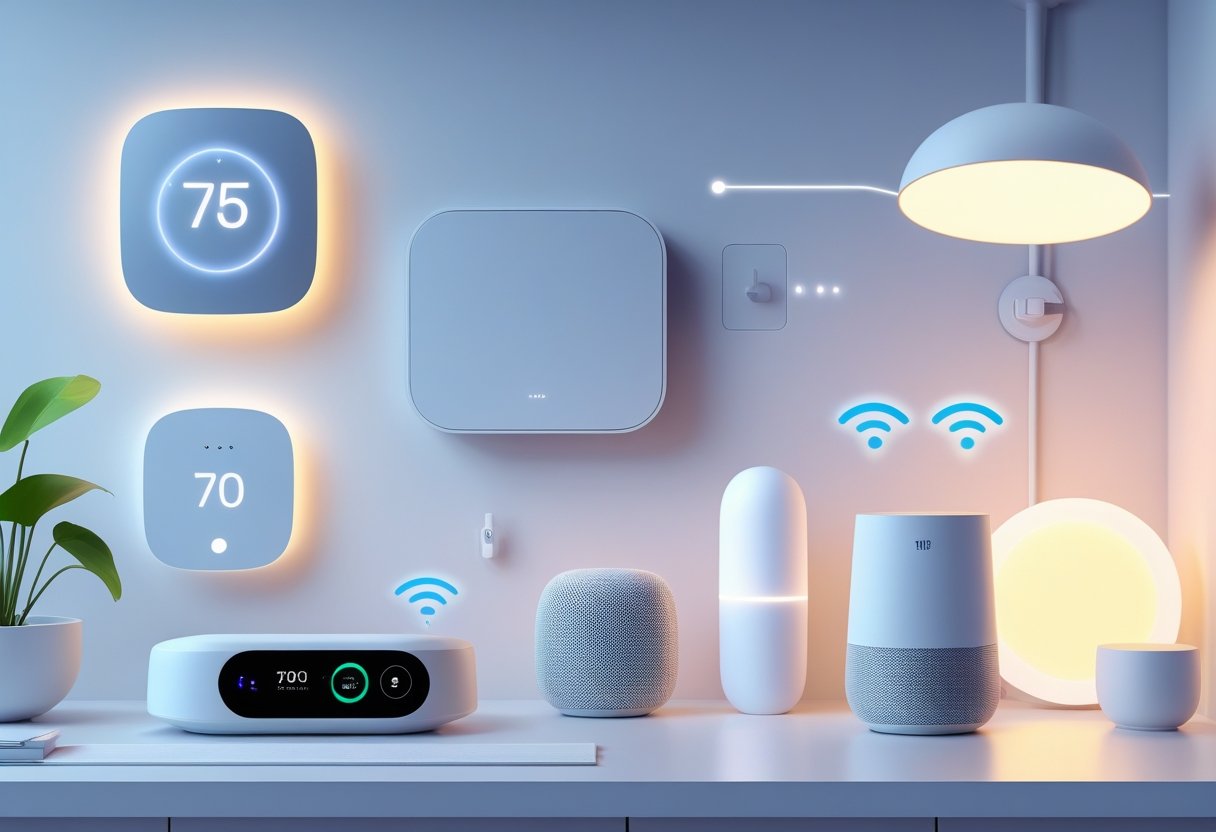
Modern homes benefit tremendously from smart technology that streamlines daily tasks and creates more organized living spaces. These innovations save time, reduce clutter, and bring convenience to everyday routines.
Voice Assistants for Daily Routines
Voice assistants have revolutionized how I manage my home. Devices like Amazon Echo, Google Nest, and Apple HomePod act as central command centers, enabling hands-free control of multiple household functions.
I find morning routines especially improved with these assistants. With simple voice commands, I can check weather forecasts, play news briefings, and manage calendars without touching a phone. This eliminates the need for multiple devices cluttering countertops.
The real organizational power comes through routines that automate multiple tasks simultaneously. For instance, saying “Good morning” can trigger lights, adjust thermostats, and start coffee makers – consolidating what would be several separate actions.
Voice assistants also excel at managing shopping lists and reminders, reducing paper clutter and ensuring I never forget essential items.
Automated Cleaning Devices
Robot vacuums and mops have transformed how I maintain clean living spaces. These devices operate on schedules or on-demand, keeping floors tidy with minimal intervention.
Popular Automated Cleaning Options:
- Robot vacuums with mapping technology
- Self-emptying cleaning stations
- Robotic mops for hard surfaces
- Window cleaning robots
The latest models feature impressive AI capabilities that learn home layouts and adjust cleaning patterns accordingly. Many connect to smartphone apps, allowing me to initiate cleaning even when away from home.
Some advanced units include self-emptying bases that eliminate the need for daily maintenance. This automation creates more consistent cleaning routines without adding to my mental load.
Smart sensors in these devices prevent collisions with furniture and detect especially dirty areas that need extra attention, ensuring thorough cleaning with minimal supervision.
Connected Storage Solutions
Smart storage options help me maximize space while maintaining easy access to belongings. Digital labeling systems with QR codes or RFID tags create searchable inventories of stored items.
Smart shelving and organization gadgets incorporate LED indicators that highlight where specific items are stored. This eliminates time wasted searching through multiple containers to find what I need.
Connected closet systems track clothing inventory and can suggest outfits based on weather or occasions. Some even monitor frequency of wear, helping identify items I should consider donating.
Smart kitchen storage includes containers that track expiration dates and automatically add depleted items to shopping lists. Pantry management systems with weight sensors detect when supplies run low.
These connected solutions integrate with home assistants to create a comprehensive organization system that reduces physical clutter while simplifying item retrieval.
Digital Decluttering Methods
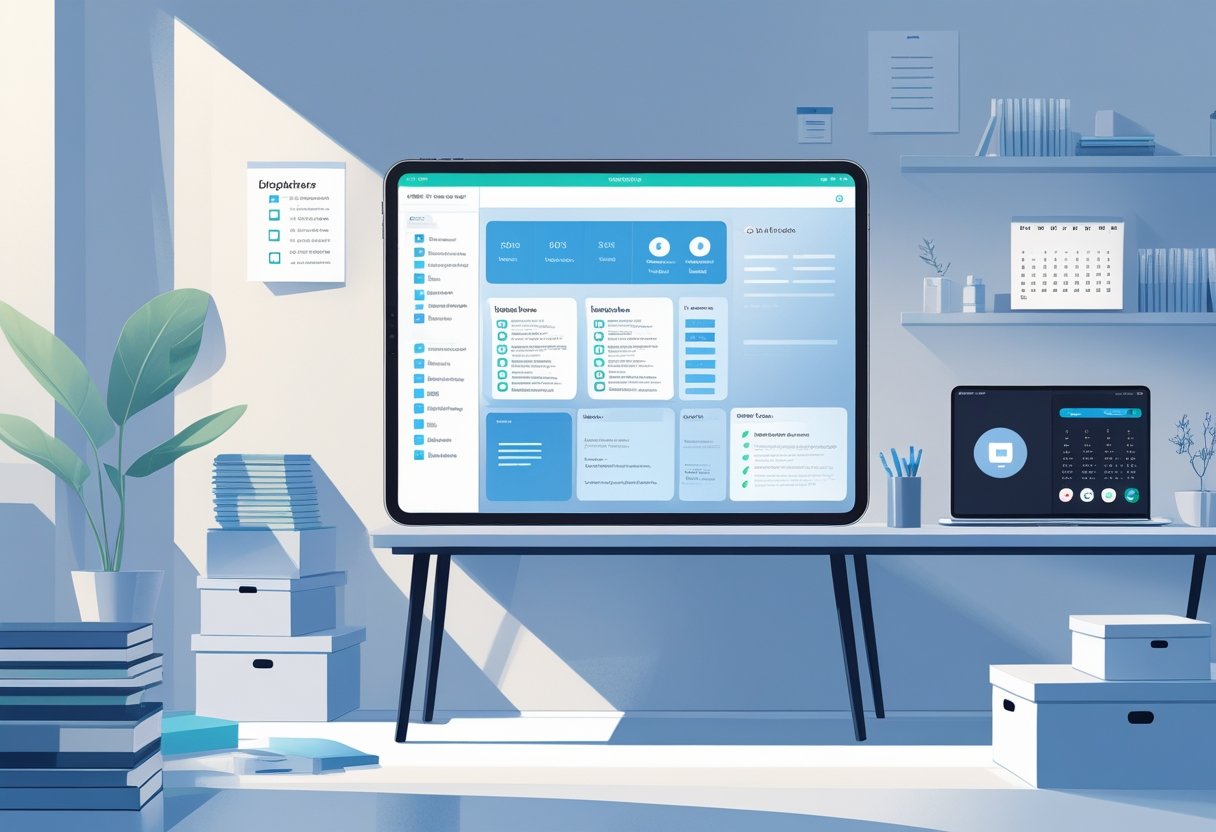
Digital clutter can be just as overwhelming as physical mess. A structured approach to organizing digital assets saves time, reduces stress, and improves productivity by making important information instantly accessible.
Organizing Digital Files and Photos
Start by creating a logical folder structure on your computer with clear naming conventions. I recommend using a main category approach (Work, Personal, Finance) with subcategories nested inside.
For photos, delete mindfully and organize by year, then by event or month. Consider these practical steps:
- Batch rename files for easy searching (e.g., “2025-05-Hawaii-Vacation”)
- Use tags for cross-categorization (family, vacation, holidays)
- Schedule monthly maintenance to sort new files
Desktop organization tools like Alfred (Mac) or Everything (Windows) can help locate files quickly. For photos specifically, Google Photos or Apple Photos automatically categorize images while providing facial recognition and search capabilities.
Decluttering Email and Communications
Email management is crucial for digital peace of mind. Start by unsubscribing from mailing lists that no longer serve your needs.
I follow a simple system with excellent results:
- Process inbox daily – respond, delete, or move to action folders
- Create filters for automatic sorting of recurring emails
- Archive completed items rather than letting them sit in your inbox
For messaging apps, regularly delete old conversations and media files that consume storage. Organize apps on your smartphone by creating folders for similar functions (productivity, social, finance) and move distracting apps to secondary screens.
Cloud Storage for Simplified Access
Cloud storage solutions provide access to your important files from anywhere while serving as excellent backups. I recommend utilizing folders and a cloud software program systematically.
Choose one primary cloud service (Google Drive, Dropbox, OneDrive) to avoid fragmentation. Mirror your local folder structure in the cloud for consistency. Enable automatic syncing for crucial folders to ensure your data stays current.
For seamless access across devices, consider:
- Shared folders for family documents or team projects
- Offline access settings for important files when traveling
- Regular audits to remove redundant or obsolete files
Remember to back up files before major decluttering sessions to prevent accidental data loss.
Family Coordination and Shared Responsibilities
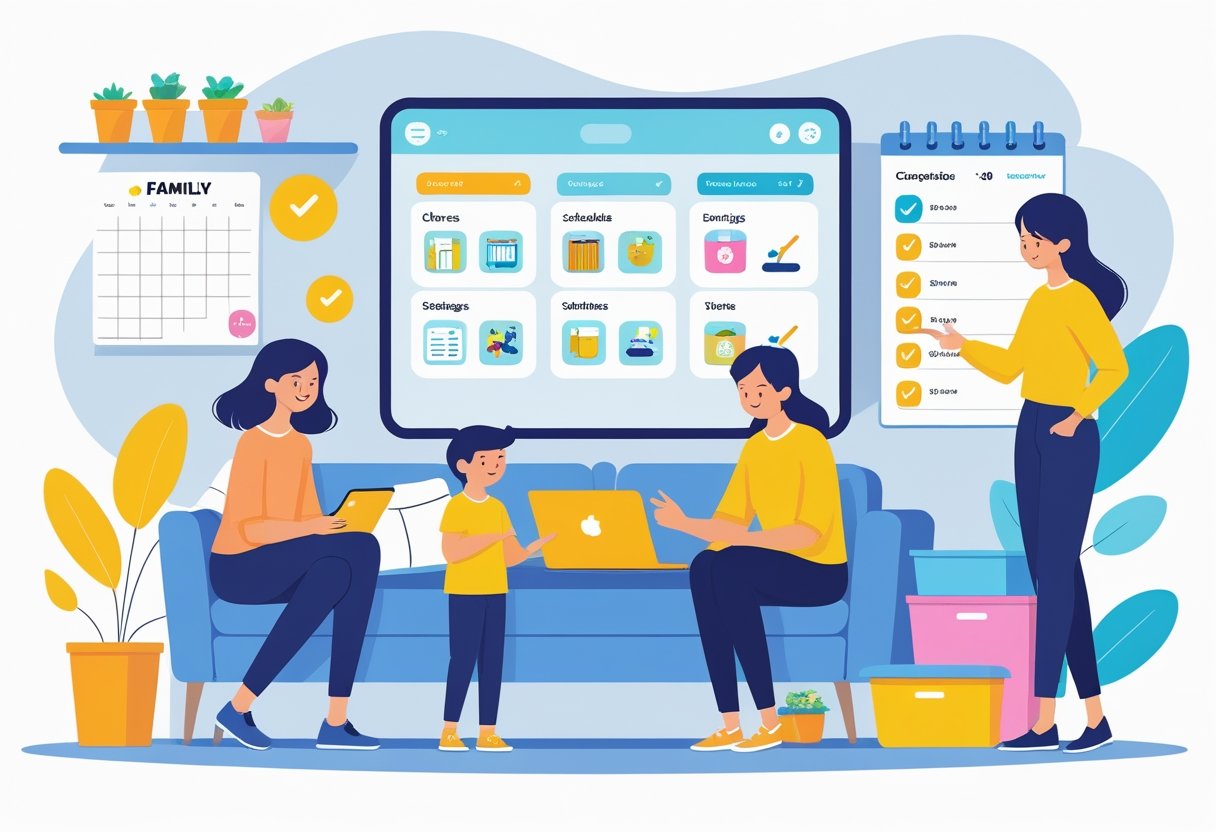
Modern families juggle numerous responsibilities and commitments that require coordination and communication. Technology offers powerful tools to streamline household management and distribute tasks fairly among family members.
Shared Chore and Shopping Lists
Digital task management apps have revolutionized how families handle household responsibilities. Apps like Todoist allow you to create shared chore lists that everyone can access, making it easy to assign and track tasks.
I’ve found that color-coding chores by family member creates clear accountability. When my children see their names next to specific tasks, they’re more likely to complete them without reminders.
Digital shopping lists have eliminated those frustrating moments of forgetting essential items. My family uses shared notes apps where anyone can add items in real-time. This prevents duplicate purchases and ensures we don’t miss anything important.
Many of these tools allow you to set recurring tasks for regular chores like taking out trash or feeding pets. The built-in reminders have reduced my need to constantly follow up with family members about their responsibilities.
Coordinating Schedules Digitally
Shared digital calendars, particularly Google Calendar, have transformed how we coordinate our busy lives. I assign each family member a unique color, making it easy to visualize everyone’s commitments at a glance.
Digital calendars allow me to set automated reminders for important events. My teenagers receive notifications before sports practices, while my spouse gets alerts about parent-teacher conferences and doctor appointments.
I’ve found that scheduling regular family meetings using calendar invites helps us stay aligned. These 15-minute check-ins ensure everyone knows about upcoming events and changing responsibilities.
Some families benefit from dedicated family organization apps that combine calendars, chore lists, and meal planning. These comprehensive tools create a central hub for all household coordination needs.
Maintaining Organization With Automation
Automation tools can transform your organizational systems from manual chores into seamless background processes. I’ve found that setting up the right automated workflows saves hours each week and ensures important tasks don’t fall through the cracks.
Recurring Reminders and Notifications
I rely on smart home automation to maintain organization without constant effort. My digital assistant reminds me when it’s time to water plants, replace air filters, or clean the refrigerator.
Calendar apps with recurring task functions help me establish cleaning routines. I set monthly reminders for deep-cleaning bathrooms and quarterly alerts for checking smoke detector batteries.
For digital maintenance, I schedule weekly prompts to process my email inbox and declutter digital files. This prevents overwhelming buildup of digital clutter.
The key is creating specific, actionable reminders rather than vague alerts. “Clean kitchen surfaces and empty dishwasher” works better than “kitchen cleanup.”
Automating Bill Payments and Subscriptions
I’ve eliminated late fees and reduced stress by automating my financial responsibilities. Setting up automatic bill payments through my bank’s online portal ensures utilities and mortgage payments happen on schedule without my intervention.
For subscription management, I use dedicated apps that:
- Track all recurring payments in one dashboard
- Alert me before trial periods end
- Identify unused or redundant subscriptions
Digital organization tools like budget trackers automatically categorize expenses and generate monthly reports. This gives me insight into spending patterns without manual data entry.
I’ve configured my system to send confirmation notifications after each automated payment processes. This maintains awareness of my finances while eliminating the tedious work of manual payments.
Choosing the Right Tech Tools for Your Lifestyle
Finding tech organization tools that align with your specific needs requires thoughtful consideration of your routines, space constraints, and personal preferences. Effective tool selection hinges on customization options, ease of use, and data protection measures.
Personalizing Solutions to Fit Your Needs
I recommend starting your organization journey by assessing your specific pain points. Are you drowning in cables, digital files, or physical gadgets? Each requires different solutions.
For cable management, magnetic cable organizers keep wires accessible yet tidy. If you’re short on space, consider multi-functional options like a wall-mounted folding desk that disappears when not in use.
Your personality should guide your choices too. Visual organizers might prefer clear smart storage bins, while minimalists might lean toward hidden storage solutions.
I’ve found that the most successful organization systems can be mixed and matched to fit your specific situation—your home layout, your daily habits, and your aesthetic preferences.
Comparing Features and Usability
When evaluating organization tools, I focus on versatility and ease of use. Look for tools with adjustable components like drawer dividers that can adapt to changing needs.
Consider these key factors:
- Setup time: Choose tools you’ll actually implement
- Learning curve: Complex systems often get abandoned
- Maintenance requirements: Low-maintenance options typically last longer
- Compatibility: Ensure new tools work with existing systems
I particularly value tools with smart features, such as label makers with Bluetooth connectivity that integrate with apps for consistent organization.
For digital decluttering, AI-powered tools are revolutionizing organization. These can help streamline your digital environment by automatically categorizing files, suggesting deletion of duplicates, and maintaining organizational systems with minimal input.
Evaluating Data Privacy and Security
I always scrutinize the privacy implications before adopting new tech organization tools. This is especially important for AI-powered solutions that may access personal information.
Before implementing any smart organization tool, I recommend:
- Reading the privacy policy thoroughly
- Checking what data is collected and how it’s used
- Verifying if data is encrypted during storage and transmission
- Researching the company’s history with data breaches
Many AI tools for home organization offer convenience but require access to your personal information. I suggest using local-storage options when possible rather than cloud-based services for sensitive documents.
For physical items containing data (old phones, drives), proper disposal is crucial. Look for tech tools that include secure data wiping features or support for responsible e-waste management. This helps prevent both clutter and potential security issues.
Frequently Asked Questions
Tech tools have revolutionized how we organize both our physical spaces and digital lives. I’ve compiled answers to common questions about using technology to declutter and organize your home more efficiently.
What tools can help with digital decluttering and organization in the home?
Digital decluttering tools like Evernote help organize notes, receipts, and important documents in one searchable platform. I recommend using cloud storage solutions such as Google Drive or Dropbox to store and access files from any device.
Smart home assistants like Amazon Echo or Google Home can manage shopping lists, set reminders for cleaning tasks, and control other smart home devices through voice commands.
File organization apps such as Files by Google or Documents by Readdle automatically categorize documents and suggest items to delete, saving valuable storage space.
How can Asana, Inc. be used to streamline home organization?
Asana works exceptionally well for family task management by allowing you to create projects for different areas of your home. I set up boards for kitchen organization, garage cleanup, and seasonal decluttering.
The assignment feature lets me delegate tasks to family members, with due dates that send automatic reminders. This eliminates the need to constantly follow up on chores.
Asana’s timeline view helps visualize long-term home projects, making it easier to break down big decluttering jobs into manageable daily tasks.
What are some effective strategies for digital decluttering?
I follow the one-minute rule: if a digital task takes less than a minute, I do it immediately—like deleting unnecessary emails or filing a document.
Implementing folder systems with clear naming conventions creates order across all devices. I use categories like “Active Projects,” “Reference,” and “Archive” to quickly locate files.
Schedule regular digital cleanup sessions. I block 30 minutes weekly to delete unnecessary photos, unsubscribe from unwanted emails, and organize downloads.
What is the best way to prioritize tasks when organizing and decluttering using the 1 3 5 method?
The 1-3-5 method involves completing one big task, three medium tasks, and five small tasks each day. For decluttering, I designate my “one big task” as tackling a full closet or reorganizing the garage.
Medium tasks might include sorting through a drawer, organizing digital photos, or cleaning out a small cabinet. These typically take 15-30 minutes each.
The five small tasks could be quick wins like deleting 10 emails, clearing one shelf, or finding five items to donate. These build momentum and provide satisfaction throughout the day.
Can you recommend any free digital tools for organizing and decluttering personal spaces?
Microsoft To Do offers simple list-making capabilities with reminders and is completely free. I use it to track daily decluttering tasks and home maintenance.
Google Keep works wonderfully for creating labeled notes about home organization ideas, measurements, and color codes without any cost.
Tody is a free basic cleaning and organization app that tracks when areas were last cleaned and suggests when they need attention again.
What systematic approach should be taken to declutter a house efficiently?
I always recommend starting with a complete inventory of problem areas, ranking them from 1-10 based on stress level and frequency of use. This helps identify priority spaces.
Use the four-box method: keep, donate, trash, and relocate. Every item must go into one category with no “maybe” pile allowed.
Work in 25-minute focused sessions using the Pomodoro technique, followed by 5-minute breaks to prevent burnout and maintain momentum throughout larger decluttering projects.
